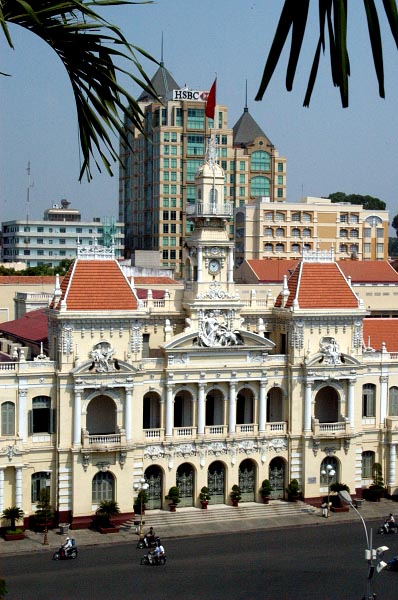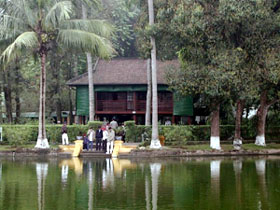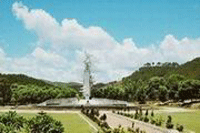HO CHI MINH CITY
 Ho Chi Minh City, from is current geographical boundary, due to its historical foundation and structure, did not have many ancient grandiose words. The most ancients, indeed were some pagodas which have been repaired several times and their forms have little more changed. Some tombs dated from 16th and 17th century were in ruin. The Ba Chieu’s Sir’s Mausoleum (grave of Ta Quan Le Van Duyet, early 19th century) was religionized in the from – I void to say it was already chinesed. Vestiges of Phu Nam and Thuy Chan Lap era were concealed in the depth-earth. Of course, architectural works in the late of 19th century and early of 20th century, still have their different attrations-Notre Dame cathedral, Doc Ly Palace (office of Municipal People’s Committee), French Governor Palace (Revolutionary Museun), the Tribunal, the Post Office… Book the best Vietnam Travel Deals from us. But fairly to say, those western European style works were more in witnesses of modern time history than to symbolize the Vietnamese culture in the South. And place names of major events during 120 years of struggle for the national emancipation were uncountable, but they weren’t landscapes and they must be touched through historical documents and knowledges but they couldn’t contact direct sightseeing, perhaps except the Cu Chi tunnels. Excavation of some places in the Go Chua, Can Gio… provided numerous relics but they interested essentially archaeologists, notionalogists, historists. To make up thet objective deficient, Ho Chi Minh City possessed a leading landscape: the Sai Gon River.
Ho Chi Minh City, from is current geographical boundary, due to its historical foundation and structure, did not have many ancient grandiose words. The most ancients, indeed were some pagodas which have been repaired several times and their forms have little more changed. Some tombs dated from 16th and 17th century were in ruin. The Ba Chieu’s Sir’s Mausoleum (grave of Ta Quan Le Van Duyet, early 19th century) was religionized in the from – I void to say it was already chinesed. Vestiges of Phu Nam and Thuy Chan Lap era were concealed in the depth-earth. Of course, architectural works in the late of 19th century and early of 20th century, still have their different attrations-Notre Dame cathedral, Doc Ly Palace (office of Municipal People’s Committee), French Governor Palace (Revolutionary Museun), the Tribunal, the Post Office… Book the best Vietnam Travel Deals from us. But fairly to say, those western European style works were more in witnesses of modern time history than to symbolize the Vietnamese culture in the South. And place names of major events during 120 years of struggle for the national emancipation were uncountable, but they weren’t landscapes and they must be touched through historical documents and knowledges but they couldn’t contact direct sightseeing, perhaps except the Cu Chi tunnels. Excavation of some places in the Go Chua, Can Gio… provided numerous relics but they interested essentially archaeologists, notionalogists, historists. To make up thet objective deficient, Ho Chi Minh City possessed a leading landscape: the Sai Gon River.
Discover the life in the biggest city of Vietnam with VIETNAM TRAVEL.
Visiting President Ho Chi Minh’s memorial site
 During the past 32 years, the site – located next to Ho Chi Minh Mausoleum and Ba Dinh Square – has received over 40 million domestic and foreign visitors who have come to see with their own eyes the working and living place of Ho Chi Minh, the beloved great leader and liberation hero of Vietnam, a great cultural man of humanity.
During the past 32 years, the site – located next to Ho Chi Minh Mausoleum and Ba Dinh Square – has received over 40 million domestic and foreign visitors who have come to see with their own eyes the working and living place of Ho Chi Minh, the beloved great leader and liberation hero of Vietnam, a great cultural man of humanity.
Even the current hot weather can not prevent visitors and local people from standing in long lines to pay tribute to President Ho Chi Minh at his mausoleum.
Mrs Nguyen Phuong Lan from Phu Minh commune and her two children were among many from Soc Son suburban district of Hanoi who often visit the memorial site every summer.
She said: “It has been our family’s tradition to travel to Hanoi and pay tribute to President Ho at his mausoleum. When I was young, my father awarded me a visit to Hanoi for my good study results.”
She recalled the joyful moments going around President Ho’s stilt house and stressed that she would continue her family’s tradition.
Many visitors also shared the same sentiments and thinking with Mrs Lan. It is not only to realise their the aspiration but also a way to express their sacred sentiments toward the beloved leader of Vietnam.
Mr Bui Kim Hong, director of the site, said that it features specially important values because it reflects truly and profoundly the daily life of President Ho Chi Minh during his 15 last years from 1954 to 1969 and also one of the most eventful periods of the nation’s history.
All documents, exhibits and vestiges relating to President Ho Chi Minh are carefully preserved as if he is still living and working. The first stop is the Presidential Palace which was formerly the governor’s palace in the French-ruled period.
After the successful resistance against the French colonialists, the house was used as a working and reception place of the Government and State following President Ho Chi Minh’s proposal.
The house witnessed much internal and external activities of President Ho as the head of the Party and State. It was also the place where he read Tet greetings to Vietnamese people at home and abroad.
The second destination is House 54 where President Ho lived and worked after returning to Hanoi from 1954 to 1958. It was this place where he drafted many important documents for the Party and State concerning the revolutionary lines for both the north and the south, initiated specific policies to meet the country’s practice and the revolution’s requirements.
On the left side is a garage displaying two cars presented by the Government of the former Soviet Union and overseas Vietnamese, a Pobeda and a Peugeot 404, which served President Ho Chi Minh during the time he worked and lived there.
Opposite House 54 and on the other side of the fish pond is a stilt house where President Ho lived and worked from 1958 to 1969.
The house was designed according to the style of stilt houses of the ethnic people in the northernmost region with a rose-mallow fence, remembering Nghe An, his native land. At this house, President Ho used to work with the Politburo and officials from different localities and received international guests together with cadres and fighters from the south. It was also the place where President Ho wrote the appeal calling on the entire people to struggle against the US aggressor for national salvation after the enemy escalated the war to the north.
He also started the first lines of his testament left for the entire Party and people. The house is preserved like he was living, including a bookshelf, a small transistor radio together with other simple things for his daily use.
Behind it is House 67 built with thick walls and its roof was made of ferro-concrete to become a safe place for him during the war. He then decided to use it as the headquarters of the Politburo. President Ho stayed in the house for treatment until he passed away on 2 September 1969.
The site also has other interesting areas such as a 3,000-metre fish pond in which assorted of fish are raised. After finishing work, President Ho used to feed the fish.
Next to it is a garden with a diverse eco-system including 161 varieties of trees and some aged over hundreds of years, creating a beautiful landscape. There still exists a star fruit tree presented by southern people to President Ho, suggesting that the southern region was always in his heart.
Also within the garden is the Xoai (mangro) Road, recalling his early morning steps as he walked and exercised. At the end of the road is a flower trellis which marks President Ho’s moving sentiments toward southern people and fighters, children and international guests.
Mr Nguyen Anh Minh, a member staff of the site’s management board said that the preservation of the relic promoted its historical and cultural value and helped visitors understand more about President Ho’s great thoughts, morals and his life devoted to the people and the nation. It is also a statement for all Vietnamese people and international friends to learn about the cultural values of Vietnam of which President Ho Chi Minh is the most significant embodiment.
Preserving historical relics of Ho Chi Minh – Eastern Truong Son trail
 The plan is aimed at systematically preserving the historical relics of Ho Chi Minh – Eastern Truong Son trail; proposing the quantity and scale of key relics to build party projects and to rank relics; building the management area for cultural and tourist services in combination with eco-tourism; keeping the pride in national heroic traditions throughout the generations and contributing to promoting tourism and socio-economic development in building a powerful country.
The plan is aimed at systematically preserving the historical relics of Ho Chi Minh – Eastern Truong Son trail; proposing the quantity and scale of key relics to build party projects and to rank relics; building the management area for cultural and tourist services in combination with eco-tourism; keeping the pride in national heroic traditions throughout the generations and contributing to promoting tourism and socio-economic development in building a powerful country.
The scale for general plan is 271.44 ha, including seven complexes of relics from Tan Ky in the Central province of Nghe An to Loc Ninh in the Central province of Binh Phuoc, and some relics in Nghe An.
There is a need to preserve ways, works, scenery, transports, military medical stations and antiaircraft battlefields.
Capital for the plan includes those from the central budget, the national objective program for culture, local budget and other legal mobilization.
The plan consists of 12 partly projects which will carried out from 2007 to 2014.